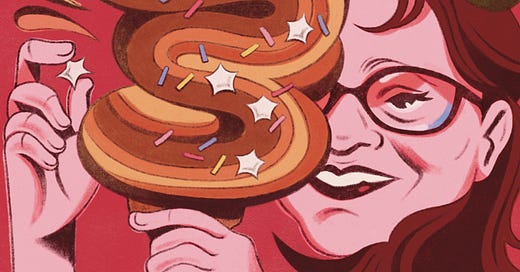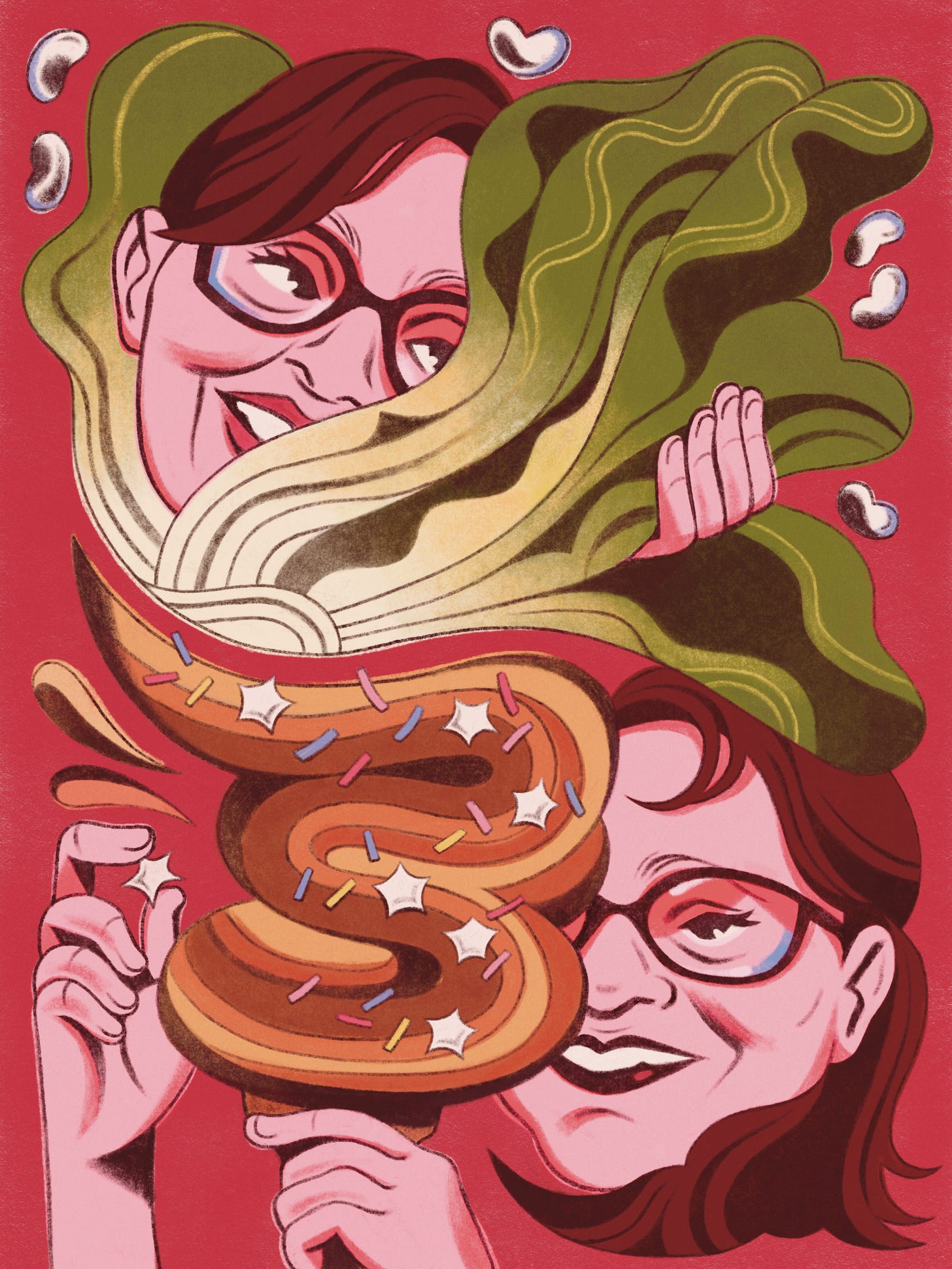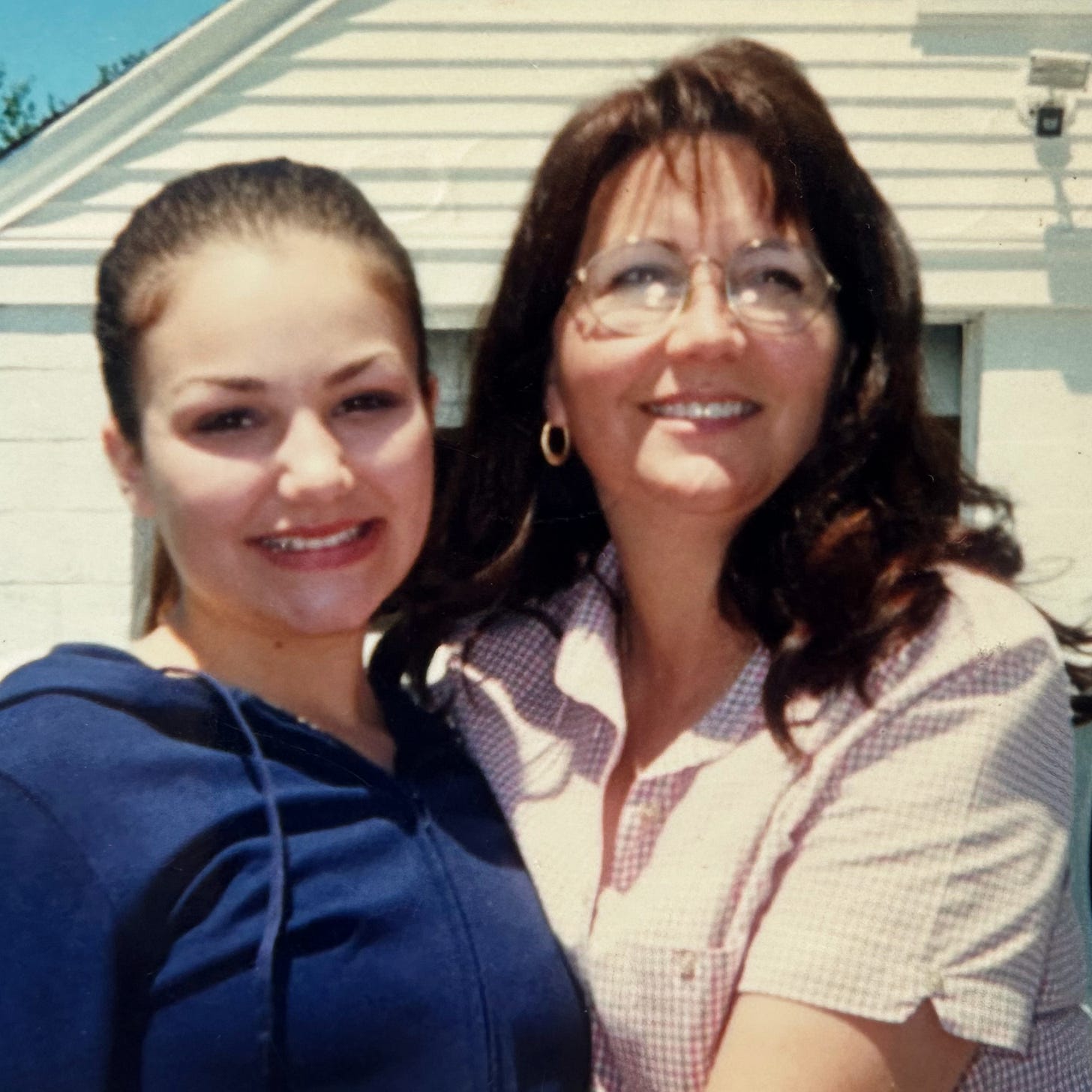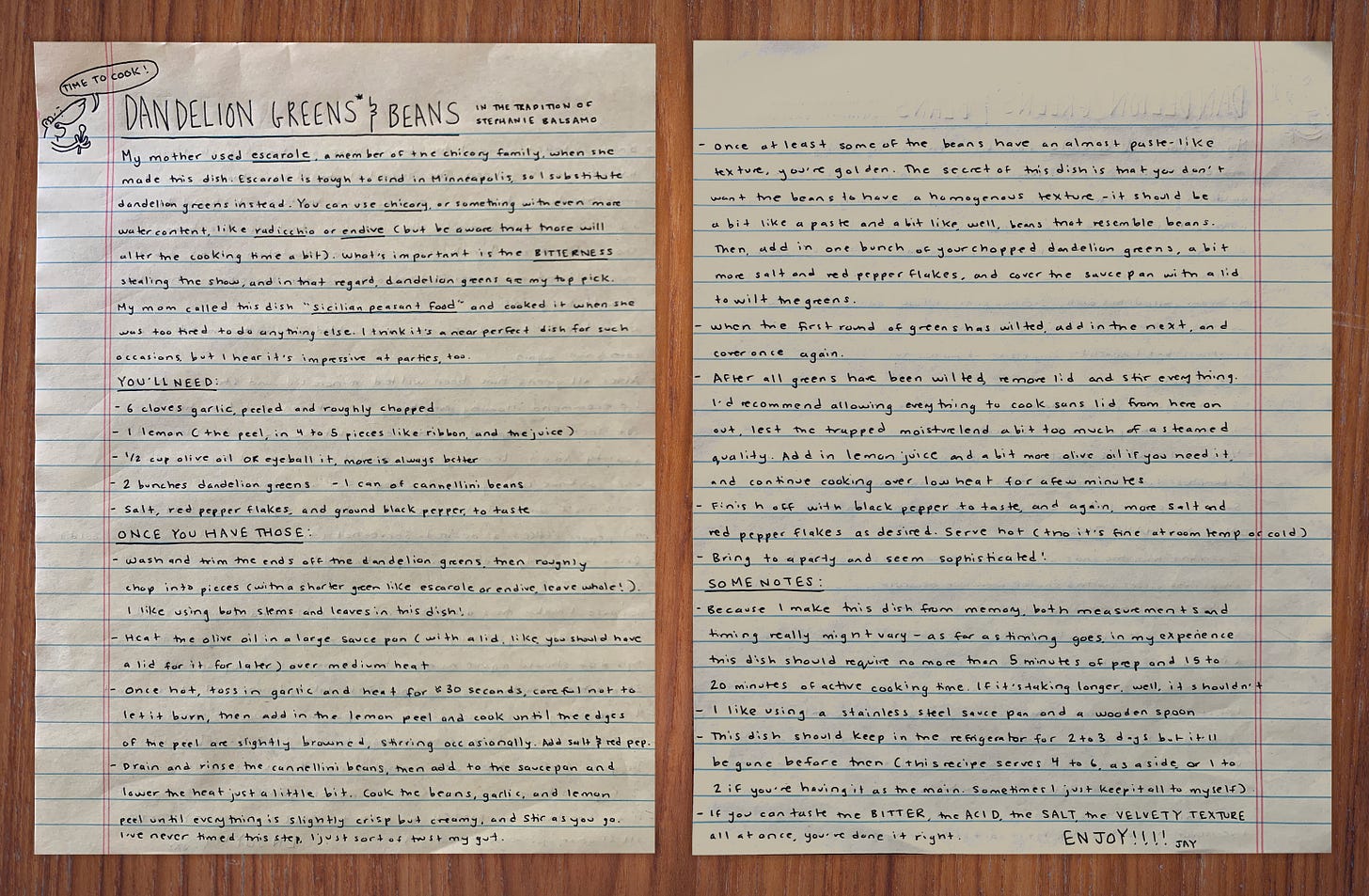This week we go for an afternoon joy ride and prepare some creamy comfort food. We also welcome Guest Gulletier Jay Eisenberg to the table.
Treat Culture
by Kitty
For Julie Kwolek
My mom was a big believer in getting yourself a little treat before it was a trend. Bad day? Little treat. Good day? Little treat. Bird shit on your windshield? Without question. She had an insatiable sweet tooth, and while chocolate seems like the obvious choice, one of her favorite flavors was coffee. Strange for someone who famously didn’t own a coffee pot while I was growing up. (We offered guests skim milk and a smile.)
In the summer, we’d visit a seasonal ice cream shop in North Providence not far from the school where she taught called Cool Licks. It had a bright pink awning and offered 24 flavors of soft serve. Having worked at an ice cream shop in high school, I know that this claim is bullshit. It simply means there’s a teen in the back squirting red dye into the vanilla and calling it strawberry. Cool Licks, though, had an extra handle on their soft serve machine. They were better than the 24 flavors that that awning boasted. Forget about chocolate, vanilla, and your classic twist…they had coffee on tap. My mom was hooked.
She’d order a small cone of coffee soft serve topped with something called crunch coat. Before it appeared through the window, she’d request that it be tipped upside down into a cup and loaded up with even more. Crunch coat was a collection of beige bits and bobs mixed with rainbow sprinkles. It looked like someone collected all of the day's crumbs into a bowl and saved them for later. I came to learn that crunch coat is essentially peanut brittle. Checks out! My mom needed to make sure that there was enough topping to be distributed throughout all of the ice cream, not just the outer layer of what appeared on the top of the cone. She knew what she was doing, and I often ordered my ice cream the same way. My preferred flavor was peanut butter, or another Cool Licks specialty, watermelon sherbet soft serve.
Sometimes we’d sit and enjoy our ice cream in the car with the windows down and the sunroof open. Other days my mom would put the bowl in her lap and somehow maneuver a cone, cup, spoon, steering wheel, blinker, and radio volume knob all at once. Grabbing yourself an afternoon snack and being on time for extracurriculars were not mutually exclusive.
When my mom passed a childhood friend reached out to recall a fond memory she had of her. One where she let us dress up in old sequined dance costumes and ride around the neighborhood singing and waving out the opened windows of her car. She laughed alongside us and made sure we each had our time to shine—that is, a turn out the roof.
On days I want to feel her presence, I pull up to that familiar pink awning and imagine the gentle side eye my mom used to give me. A knowing glance as if to say, “loosen up, and enjoy the goddamn wind in your hair.” A word of advice next time you’re at the ice cream window—don’t be afraid to ask for more.
The Verdict: Live fast*, loose, and covered in sprinkles.
Name Drops: Cool Licks
*20 in a school zone
What Ails You
By Jay Eisenberg1
For Stephanie Jean Balsamo
1.
My mother always told me I think you’d be very happy alone, which sounds worse than it is.
I suspect the sentiment had more to do with her desire to be alone than anything else. When her friends would ask about my romantic prospects, who I was seeing, if I had settled down with anyone yet, she would deliver her stock response in a tone that sat squarely at the intersection of pride and shame: he’s left a trail of brokenhearted men and women all up and down the east and west coasts.
Queer men have such particular relationships with our mothers, a vulgar and shimmering specificity that fills in the cracks between the ways you made her proud and the ways you disappointed her. Despite it all, my mother loved her sexually ambiguous, heartbreaking rake of a son, perpetually presumed both bicoastal and bisexual. Regrettably, she died before she could see me break my fair share of Midwestern hearts. I’m unsure why my mother assumed I was always the one doing the heartbreaking. No one wants to see their son heartbroken, I suppose. Better, perhaps, to wish him the life of autonomy and well-tended solitude you never had.
Better, perhaps, to teach him early and often: if you want something done right, you have to do it yourself.
2.
Stephanie refused help in the kitchen, a routine suspiciously and inextricably linked to the one where she would sit down to eat and sigh I have to do everything around here. When I eventually pleaded and proved my way into sous chef duties, I have to do everything around here was swapped out for Well, now I’m too tired to eat. The pantry was well-stocked with dozens of cans of cannellini beans, reserved for exactly such exhausted occasions. Escarole and beans was a dish for the too-tired nights, the beyond-tired nights, which predictably fell on a Wednesday.
It’s Italian peasant food, she’d always say, nothing special, as though it wasn’t the dinner that made all of us audibly moan with pleasure, love at first bite. As though it wasn’t the most treasured recipe I would come to inherit from her. As though it wasn’t the meal that would woo my future lovers and comfort my grieving friends. As though it wasn’t the dish I now make for myself on my own too-tired nights, my beyond-tired nights, which predictably fall on a Wednesday.
3.
I have a reputation among my loved ones for introducing them to the same bitter greens my mother taught me to appreciate from a young age: escarole, dandelion greens, and radicchio. My mother had a pronounced taste for the bitter, rivaled only by her taste for salt. I have a recurring dream where I am digging through towering salt mounds in search of her costume jewelry, on the same beach where, in waking life, we flung her ashes into the sea in a tacky biodegradable urn.
The urn bobbed up and down in the Atlantic for exactly twelve minutes before it sank. My sister and father and I kept our eyes glued to it the whole time, as though she might leap out fully formed and even better than before, as though she might decide to stick around after all; twelve minutes suspended in the space between coming and going, between going and gone, between bitter and sweet.
4.
Bitter is good for you, my mother would tell me when I retched at my early exposure to it. At 34, I often prefer to make this dish with the bitterest of dandelion greens instead of escarole; an acquired taste for the sophisticated, if not slightly masochistic, palate. Bitter is buoyant, alerts you to your own aliveness, reminds you that you’re not dead, not just yet. Most poisons announce themselves with bitterness for a reason, and most medicines do, too. My herbalist always tells me herbs cure what they cause and cause what they cure. When she offered me a heart-opening tincture to clear a path for my fresh heartbreak, I told her no, no thanks, I don’t want a heart-opening blend right now, I’d prefer a heart-closing blend thankyouverymuch.
It’s not about feeling better, Jay, she said. It’s about feeling more.
My mother’s maiden name was Balsamo.
A balm, a comfort, a bittersweet vinegar to cure or cause what ails you.
5.
Between you and me, greens and beans is a bonafide crowd-pleaser, sure to impress at parties; a reminder that what you bring to the table is more than enough even when you feel inescapably and resoundingly less-than. In teaching me to cook this dish, my mother taught me how to take care of yourself at your loneliest, your most exhausted, your most depressed, your most brokenhearted. I cook escarole and beans each year on the anniversary of her death, July 20th. I always prepare enough for the two of us, plus a little extra for the following day. I call this “a gift for Future Jay” because I know that come July 21st my grief will still be there, a little different than before.
I set two places at the table. I always give her whichever plate looks prettier.
I imagine her sitting down across from me with a sigh.
Are you still too tired to eat? I ask.
6.
My mother insisted I learn this recipe not because it’s an easy dish, but because it is a simple dish that requires a great deal of attention. If you’re doing it right, you teach your son that ease is hardly an indication of aliveness. If you’re doing it right, you teach your son that Paying Attention is almost always the solution.
Are you attentive enough to notice the bitterness of the greens? The creaminess of the cannellini beans? The way the toasted lemon peel curves like the corner of your mother’s smile, the way the smell of garlic never fails to make a new house feel like home? The weight of the wooden spoon in your hand? The handsomeness of your reflection in the saucepan, gazing back at you? Are you skimping on your ingredients? Are you compromising? Are you making yourself smaller? Are you saying yes to less than you want? For what? For whom? Are you alive yet? How about now? If not, what are you waiting for?
If you want something done right, you have to do it yourself.
But if you’re lucky, your mother will teach you how.
A special thank you to this week’s illustrator, Michelle Perez2 ! Michelle is also illustrating all of our Guest Gulletier portraits on Instagram for the month of May. See more of her work here.
If you’d like to be a Guest Gulletier or illustrator, drop us a note at putitinthegullet@gmail.com
Jay Eisenberg is a theatre-maker, arts educator, and cultural consultant based in Minneapolis, MN by way of NYC. He has his mother’s laugh, his father’s smile, and with any luck, will one day have Stanley Tucci’s arms. More at: www.jay-eisenberg.com
Michelle Perez is an illustrator based in Providence, Rhode Island. Her work embraces fluidity and movement to tell compelling stories. When she's not drawing, she loves taking long strolls and savoring her carefully crafted playlists.







